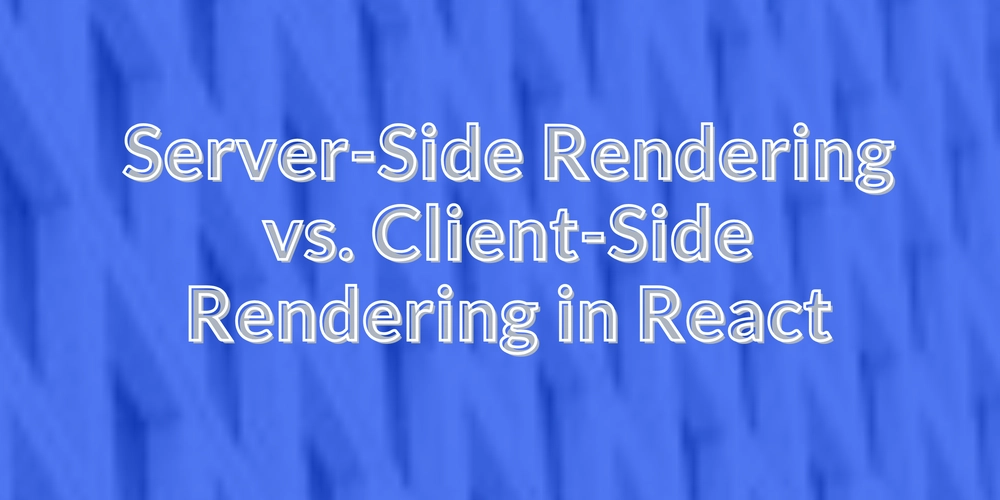Server-Side Rendering vs. Client-Side Rendering in React
In the modern web development landscape, React.js has emerged as one of the most popular JavaScript libraries for building dynamic and interactive user interfaces. However, it is among the crucial decisions that developers need to ponder on before developing a React application-the decision between using Server-Side Rendering (SSR) and Client-Side Rendering (CSR). Each rendering option comes with its own advantages and disadvantages and affects SEO, performance, and user experience. The blog is meant to be about Server-Side Rendering (SSR) and Client-Side Rendering (CSR). We will clear all your doubts regarding the two techniques, compare their differences and work of the two, state the advantages and disadvantages of each, and help you figure out when best to use one over the other. For those looking to enhance skill levels and learn to build high-performance React applications, there's always React JS Training in Chennai, where one gets to experience firsthand both rendering types. What is Server-Side Rendering (SSR)? With Server-Side Rendering (SSR), the rendered results of the React application are created at the server end before sending it to the browser of the particular client. The server creates the rendering of React components into HTML using the final content as output and sends it to the browser where it is shown as instantaneously. How SSR Works: A request made by a user. The server starts to process this request and renders the React components into static HTML, which the server sends back to the browser. All occurs instantaneously. Then it takes over React and begins to hydrate the application so that it can be entirely interactive. Advantages of SSR: Better SEO: Search crawlers are able to index the complete-rendered HTML content that a site has to offer, thus improving the chances of being found through search engines. Faster First Load Time: Since the HTML has been pre-rendered, the users view the content much faster, improving time to first byte (TTFB). Better Performance for Slow Devices: Because rendering happens on the server, low-end devices are expected to perform significantly better. Disadvantages of SSR: Increased server load: Since the server has to support dynamic HTML rendering on every client request, this can be resource-consuming. Enhanced Complexity: To make SSR possible, additional configurations like the Node.js server need to be set up, which would include hydration management. Delayed Interactivity: The content can be displayed faster, but the entire page has to be hydrated to be fully interactive. Client-Side Rendering (CSR), in simpler terms, is the default methodology where the rendering of React components occurs in the browser directly on the client-side and not on a server. Working of CSR: The first step is when the user makes a request to the server. Then, the server responds with a minimal HTML page that contains the JavaScript bundle. This JavaScript is so loaded in the browser which initiates and creates UI dynamically by executing React. Interactively, the page reacts as soon as React has finished loading and executing. Pros of Client-Side Rendering: Rich Interactive Experiences: CSR allows entirely dynamic interaction with the user and single-page applications, which avoid a full-page reload. Reduction of the Server Load: The server is very efficient in catering to a larger number of concurrent users since it only sends static assets (HTML, JavaScript, and CSS). Improved Caching: After the JavaScript is downloaded, page switching becomes faster since the updates are done locally by React. Cons of Client-Side Rendering: Slow Initial Load Time: Since their initial rendering depends on downloading and executing JavaScript, CSR applications spend excessive time loading the first screen. SEO Compatibility: Invoking content generation dynamically may not be compliant with indexing of search engine crawlers, unless you take measures like pre-rendering or dynamic rendering. Increased Client-Side Computation: Rendering on the client requires more computing power, which may affect performance on low-end devices. The hybrid approach calls for a combination of SSR and CSR based on application requirements. Frameworks like Next.js provide the capability to implement Static Site Generation and Incremental Static Regeneration alongside SSR. Therefore, optimum performance is achieved when all three rendering techniques are used. For example: Public pages (landing pages, blogs, product pages): SSR or SSG in order to improve SEO. User dashboard pages: CSR for a dynamic and immersive experience. Final Thoughts In the end, Server-Side Rendering and Client-Side Rendering both have their pros and cons, and the choice depends on your project requirements, including performance, SEO capabilities, and scalability. If your site is SEO-driven, you've got to choose SSR. If it is more interactive and user-driven, go with CSR. To truly master these

In the modern web development landscape, React.js has emerged as one of the most popular JavaScript libraries for building dynamic and interactive user interfaces. However, it is among the crucial decisions that developers need to ponder on before developing a React application-the decision between using Server-Side Rendering (SSR) and Client-Side Rendering (CSR). Each rendering option comes with its own advantages and disadvantages and affects SEO, performance, and user experience.
The blog is meant to be about Server-Side Rendering (SSR) and Client-Side Rendering (CSR). We will clear all your doubts regarding the two techniques, compare their differences and work of the two, state the advantages and disadvantages of each, and help you figure out when best to use one over the other. For those looking to enhance skill levels and learn to build high-performance React applications, there's always React JS Training in Chennai, where one gets to experience firsthand both rendering types.
What is Server-Side Rendering (SSR)?
With Server-Side Rendering (SSR), the rendered results of the React application are created at the server end before sending it to the browser of the particular client. The server creates the rendering of React components into HTML using the final content as output and sends it to the browser where it is shown as instantaneously.
How SSR Works:
A request made by a user.
The server starts to process this request and renders the React components into static HTML, which the server sends back to the browser.
All occurs instantaneously.
Then it takes over React and begins to hydrate the application so that it can be entirely interactive.
Advantages of SSR:
Better SEO: Search crawlers are able to index the complete-rendered HTML content that a site has to offer, thus improving the chances of being found through search engines.
Faster First Load Time: Since the HTML has been pre-rendered, the users view the content much faster, improving time to first byte (TTFB).
Better Performance for Slow Devices: Because rendering happens on the server, low-end devices are expected to perform significantly better.
Disadvantages of SSR:
Increased server load: Since the server has to support dynamic HTML rendering on every client request, this can be resource-consuming.
Enhanced Complexity: To make SSR possible, additional configurations like the Node.js server need to be set up, which would include hydration management.
Delayed Interactivity: The content can be displayed faster, but the entire page has to be hydrated to be fully interactive.
Client-Side Rendering (CSR), in simpler terms, is the default methodology where the rendering of React components occurs in the browser directly on the client-side and not on a server.
Working of CSR:
The first step is when the user makes a request to the server.
Then, the server responds with a minimal HTML page that contains the JavaScript bundle.
This JavaScript is so loaded in the browser which initiates and creates UI dynamically by executing React.
Interactively, the page reacts as soon as React has finished loading and executing.
Pros of Client-Side Rendering:
Rich Interactive Experiences: CSR allows entirely dynamic interaction with the user and single-page applications, which avoid a full-page reload.
Reduction of the Server Load: The server is very efficient in catering to a larger number of concurrent users since it only sends static assets (HTML, JavaScript, and CSS).
Improved Caching: After the JavaScript is downloaded, page switching becomes faster since the updates are done locally by React.
Cons of Client-Side Rendering:
Slow Initial Load Time: Since their initial rendering depends on downloading and executing JavaScript, CSR applications spend excessive time loading the first screen.
SEO Compatibility: Invoking content generation dynamically may not be compliant with indexing of search engine crawlers, unless you take measures like pre-rendering or dynamic rendering.
Increased Client-Side Computation: Rendering on the client requires more computing power, which may affect performance on low-end devices.
The hybrid approach calls for a combination of SSR and CSR based on application requirements. Frameworks like Next.js provide the capability to implement Static Site Generation and Incremental Static Regeneration alongside SSR. Therefore, optimum performance is achieved when all three rendering techniques are used.
For example:
Public pages (landing pages, blogs, product pages): SSR or SSG in order to improve SEO.
User dashboard pages: CSR for a dynamic and immersive experience.
Final Thoughts
In the end, Server-Side Rendering and Client-Side Rendering both have their pros and cons, and the choice depends on your project requirements, including performance, SEO capabilities, and scalability. If your site is SEO-driven, you've got to choose SSR. If it is more interactive and user-driven, go with CSR.
To truly master these rendering techniques and create performing React Applications, it is strongly recommended to do React JS Training in Chennai. Hands-on training from a team of experts will give good insight into implementing SSR, CSR, and hybrid techniques in real-world applications.
These rendering strategies will help you in boosting your efficiency in React development while tuning the web applications for speed and usability. Regardless of what route you choose, be it SSR, CSR, or hybrid, knowing when to and how to leverage these will enable you to create powerful, scalable, and high-performing React applications.











































































































































































![[The AI Show Episode 142]: ChatGPT’s New Image Generator, Studio Ghibli Craze and Backlash, Gemini 2.5, OpenAI Academy, 4o Updates, Vibe Marketing & xAI Acquires X](https://www.marketingaiinstitute.com/hubfs/ep%20142%20cover.png)




























































































































![[DEALS] The Premium Learn to Code Certification Bundle (97% off) & Other Deals Up To 98% Off – Offers End Soon!](https://www.javacodegeeks.com/wp-content/uploads/2012/12/jcg-logo.jpg)


![From drop-out to software architect with Jason Lengstorf [Podcast #167]](https://cdn.hashnode.com/res/hashnode/image/upload/v1743796461357/f3d19cd7-e6f5-4d7c-8bfc-eb974bc8da68.png?#)








































































































.png?#)

































_Christophe_Coat_Alamy.jpg?#)
 (1).webp?#)





































































































![Apple Considers Delaying Smart Home Hub Until 2026 [Gurman]](https://www.iclarified.com/images/news/96946/96946/96946-640.jpg)
![iPhone 17 Pro Won't Feature Two-Toned Back [Gurman]](https://www.iclarified.com/images/news/96944/96944/96944-640.jpg)
![Tariffs Threaten Apple's $999 iPhone Price Point in the U.S. [Gurman]](https://www.iclarified.com/images/news/96943/96943/96943-640.jpg)




































































































































